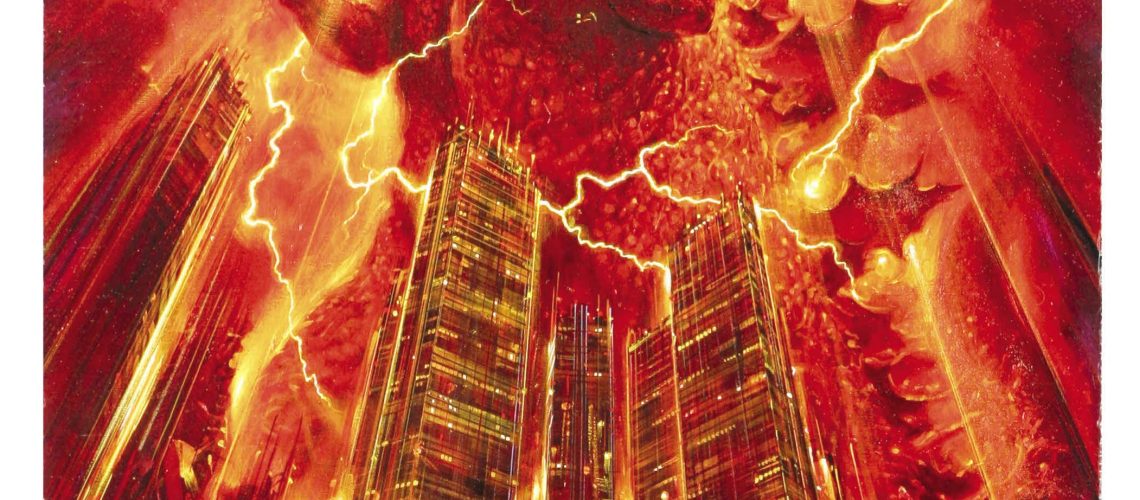In 1985, I had the chance to see Godzilla on the big screen for the first time since that treasured day in the mid-70s, when my father took me to a matinee of Godzilla vs. the Thing (aka Mothra vs. Godzilla, 1964). On this occasion, the film was Godzilla 1985 (aka The Return of Godzilla, 1984). Like the 1954 original, it had been re-edited by its American distributor, with Raymond Burr shoehorned in. It was also dubbed. I didn’t care. It was Godzilla. When a couple of kids (about eight years old, I’m guessing) called out “Hi, Godzilla!” when he appeared, I barely restrained myself from doing the same. But there was another voice in that theatre. In the row ahead of me, a couple sat with their daughter. She was young enough (four? five?) that it’s possible this was her first movie. Twice during the film, I heard a small voice emerge from the seat in front of me with a quavering, “This scares me.” The first time was early in the film, when a corpse is found on a derelict ship. The second time was when Godzilla’s massive foot comes down on a fleeing crowd.
We all, I suspect, have our early memories of being frightened by something at the movies. For many of us, it is the Disney Trauma (TM). My own is the “Night on Bald Mountain” sequence from Fantasia, which I saw when I too was four or five. I do hope that the woman this little girl became looks back on this film, as I do my Fantasia terror, with delight. But I mention this incident because there was someone in that theatre for whom seeing Godzilla was terrifying. We are still months away from the latest American take on Godzilla, but however the film itself turns out (my hopes and expectations are very high, I confess), the trailers themselves are, it seems to me, an attempt to give adults a dose of the terror that little girl experienced in 1985. And this is, I believe, a very particular form of terror.
I’ve written about some of this before (in G-FAN #69, if you’re interested), but at the risk of repeating myself, one of the best examples I know of getting things half-right is this passage from Tom Hutchinson and Roy Pickard’s Horrors: A History of Horror Movies: “Why Godzilla ultimately fails as a monster that has any connection with the ‘classic’ monsters is because he is so above humanity as to have nothing to do with it.” Setting aside all Godzilla films from the mid-60s to mid-70s, where he became quite the tame, lovable character, my contention is that Godzilla’s success is precisely because he is so far above humanity. At their most powerful, the Godzilla films tap into Edmund Burke’s sublime terror.
Burke writes: “No passion so effectually robs the mind of all its powers of acting and reasoning as fear. For fear being an apprehension of pain or death, it operates in a manner that resembles actual pain. Whatever therefore is terrible, with regard to sight, it is sublime too, whether this cause of terror be endued with greatness of dimensions or not; for it is impossible to look on anything as trifling, or contemptible, that may be dangerous. There are many animals, who though far from being large, are yet capable of raising ideas of the sublime, because they are considered as objects of terror. As serpents and poisonous animals of almost all kinds. And to things of great dimensions, if we annex an adventitious idea of terror, they become without comparison greater. […] Indeed, terror is in all cases whatsoever, either more openly or latently, the ruling principle of the sublime.” (My emphasis in bold.)
This is what Godzilla and his kaiju kin can offer, as implied by the above poster for The Return of Godzilla. (It is certainly what I attempted to do in my story in the Kaiju Rising: Age of Monsters anthology.) And it is what the trailers for Godzilla are seeking to evoke. From the Oppenheimer quotation from the leaked trailer, to the repeated shots of overwhelming awe and terror on the faces of the characters, to the horror and desperation in Bryan Cranston’s monologue in the most recent trailer, to omnipresence of the Ligetti score, to the glimpses of something incomprehensibly gigantic, everything here is seeking to conjure that terrible sublime. I see echoes, too, of Yeats’s “vast image out of Spiritus Mundi.”
With his “gaze blank and pitiless as the sun,” perhaps the hour has indeed come round at last for this rough beast.










3 Responses
I look forward to our podcast recording next week
You mean today? 🙂